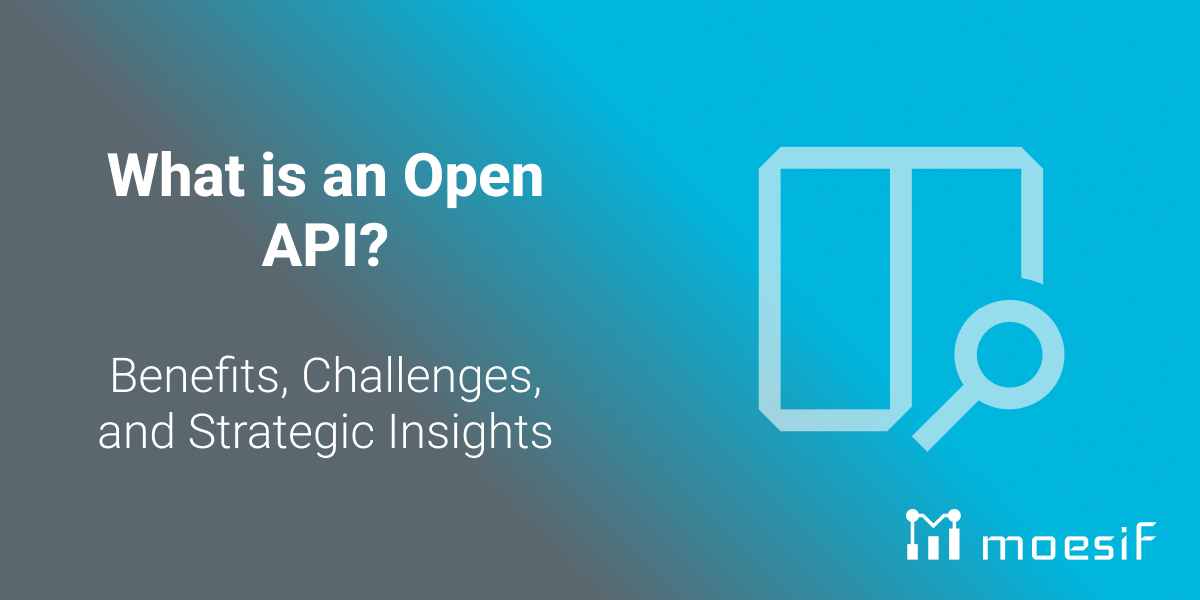What is an Open API? Benefits, Challenges, and Strategic Insights

An open or public API is a freely accessible application programming interface (API) that allows you to interact with a software application or service. Without restrictive access barriers, an open API empowers organizations to build innovative solutions and extend existing ones. But embracing a public API can present challenges related to security, governance, and maintenance that organizations need to address strategically.
In this article, we promise a no-nonsense exploration of open APIs, their functions, benefits, and security aspects. We demystify how they underpin tech innovation and enable seamless integration across various services and platforms.
Key Takeaways
- Open or public APIs provide universal and programmatic access to proprietary software services to anyone who wants to access them. These APIs foster innovation and facilitate the reach of applications by allowing software developers to integrate and extend existing software without needing special permissions.
- Security poses a significant concern for open APIs as they are publicly accessible over the internet, making them more vulnerable to attacks. To mitigate security risks, API development teams perform network traffic inspection, install security tools, and employs data transmission standards such as SSL and TLS 1.2.
- Proper management of open APIs involves careful versioning and updating strategies to maintain system stability, scalability, performance, and consumer trust. It’s also important to actively engage with the developer community to promote adoption and continuous improvement.

Demystifying Open API: A Primer

An open API allows developers to programmatically access proprietary software applications or web services. Any individual or entity can access them.
By offering a level playing field for developers, open APIs foster innovation and extend the reach of software applications.
The Core Characteristics of Open APIs
An open API, by design, remains publicly accessible from anywhere on the open internet without requiring special permission or access restrictions. Open APIs are the epitome of openness and interoperability, providing developers with enhanced capabilities to create innovative applications and services by integrating and extending existing software. An open API prioritizes easy consumption and access by a wide array of clients, and promotes widespread use and interoperability.
Open APIs usually offer programmatic access to proprietary software services. They provide a language-agnostic interface to RESTful services, giving developers the freedom to use their preferred programming languages.
The OpenAPI Specification (OAS), a specification for machine-readable API definitions, forms the backbone of REST APIs. An OpenAPI document details all available endpoints and operations, their parameters, responses, and security measures. OpenAPI aims to describe, produce, consume, and visualize RESTful web services, providing a standard and programming language agnostic interface for HTTP APIs. It also allows developers to provide an API specification encoded in a JSON format or YAML format.
Comprehensive API specifications foster a rich ecosystem around open API, promoting developer engagement and innovation. By adhering to a well-defined specification like the OpenAPI specification, developers can ensure seamless integration and compatibility across various platforms and services.
Open API vs. Closed API: Understanding the Differences
An open API provides free and universal access at all times. Anyone can access the services of an open API if they know the corresponding URI and parameters. A closed API on the other hand have restricted access, typically necessitating calls through firewalls or VPNs.
Organizations use closed APIs predominantly for managing controlled access of sensitive information to employees and members. Closed APIs also drive internal services and processes such as microservices, container orchestration, and internal backend systems. In contrast, open APIs deliver user-driven services and capabilities. For example, an external developer can build a travelling application that uses open social media APIs. When you go on a trip or visit a place, the application can automatically post your status on social media sites that you have linked the application to.
Closed APIs require security measures and authentication to control access, in contrast to open APIs that allow access to anyone without authentication. Despite the open nature of open APIs, they offer significant advantages to developers and organizations alike. For developers, open APIs reduce dependencies between teams, save time on code fixes, and provide the flexibility to use preferred development tools.
For organizations, they enable expanding their user base, creating new revenue streams, and fostering innovation without investing heavily in niche software development.
Security Protocols in Open APIs

While open APIs unfold a world of possibilities, they also bring along their fair share of security challenges. Due to an open API’s public accessibility over the internet, it poses a greater security risk than a closed API accessible only through an organization’s internal network. Potential fallout from security incidents involving open APIs can pose severe circumstances, such as data breaches or server crashes due to API manipulation.
Therefore, organizations must ensure secure design, proper management, and security measure around open APIs. Having these systems in place prevents bugs, security flaws, and private data leaks.
Network Traffic Inspection and Security Tools
In the realm of open API security, inspection tools play a pivotal role. These tools enable the monitoring and examination of data transfers, thus enhancing the security of open APIs. A network inspector can offer timeline views for analyzing the sequence of API communications, along with detailed connection and thread views to investigate network request security.
These tools also offer the ability to visualize REST APIs. They can also set custom rules and parameter object configurations, crucial in testing application behaviors during various network response conditions. This enhances the security of both open or public API and private API, as well as client code, by allowing security teams to anticipate and prepare for different threat scenarios.
Holistic API security solutions like Noname Security offer comprehensive protection against a suite of vulnerabilities, including misuse and data leakage, often without needing to modify the network.
Data Transmission Standards: SSL and TLS 1.2
Secure Socket Layer (SSL) and its successor, Transport Layer Security (TLS) 1.2, play a crucial role in securing data transmission. They secure APIs through various functions. For example:
- Encrypting the transmitted data between clients and servers.
- Reinforcing data confidentiality, integrity, and authenticity.
- Ensuring a secure handshake process.
- Providing forward secrecy.
SSL/TLS integration into API infrastructure involves obtaining SSL certificates from trusted authorities and configuring them on servers to establish secure connections. They typically don’t require major changes to existing systems. A more secure variant, mutual TLS (mTLS), allows mutual authentication over TLS, providing an additional layer of security in sensitive industries.
To maintain the security integrity of APIs, perform regular renewal and vigilant auditing of SSL/TLS certificates. Nowadays you can use automated tools that specialize in auditing and renewing certificates, while also assisting in monitoring and managing potential vulnerabilities.
Real-World Applications of Open APIs

Open APIs provide indispensable value across various sectors. They enable connectivity and data exchange that are essential for modern industry innovations. The following examples illustrate how different industries use open APIs :
- The healthcare industry leverages open APIs to meet regulatory requirements and improve patient care.
- Travel industries use open APIs for booking services across airlines, hotels, and car rental companies. They also link to different travel agencies, credit cards, and other services. All of this stands on the shoulders of open APIs.
- E-commerce platforms use open APIs to integrate with other systems for omnichannel commerce.
- Streaming services like Netflix use APIs to enhance content discovery for users.
- Social media platforms rely on open APIs for various interactive features.
In manufacturing, open APIs help automate and optimize production processes, as well as enable smarter connections with customers and facilitate real-time monitoring.
In Emerging technologies like artificial intelligence (AI), internet of things (IoT), augmented reality (AR), virtual reality (VR), and blockchain, we see an increasing dependence on public APIs. Especially, for immersive technologies like AR and VR, public APIs play a crucial part in seamless integration, delightful user experiences, and consistent evolution.
Open APIs contribute to a company’s brand strength by supporting the development of a rich third-party developer ecosystem, promoting innovation and usability.
Open Data Initiatives
Open APIs also play a significant role in government Open Data initiatives. They serve government functions in new ways, like making taxation information or public registries accessible without requiring specialists. Government Open Data initiatives aim to enhance transparency and accountability by offering public access to government-held data, thereby driving civic tech innovation.
Remote Teams
In the era of remote working, open APIs serve as the backbone of collaboration. They provide access to data catalogs and facilitate data discovery, analysis, and integration through standard data formats like CSV, XML, JSON. Remote teams can collaborate more effectively with access to government data provided by Open Data initiatives, useful for a variety of projects and analysis. Open Data catalogs offer intuitive access to data without requiring registration, promoting exploration and usage by developers.
Greater Functionality in Cloud-Based Solutions
Open APIs also enhance the functionality and security of cloud-based solutions, including virtual call centers. They allow call agents to access cloud-based phone systems directly. This leads to more efficient call center operations by integrating with CRM systems and enabling setup and enhancement of call center features.
The adoption of open APIs enables secure accessibility to diversified data types. This allows connection and integration of different security systems, promoting comprehensive data sharing.
Open APIs also aid in building a shared language and common goals among developers, security professionals, and other stakeholders, improving collaborative efforts. Major cloud-based solutions providers, including Amazon Web Services, Microsoft Azure, Google Cloud, and Okta, have embraced open APIs to bolster their security tools and services.
Best Practices for Managing Open APIs

A powerful tool like open API requires effective management for reaping its full benefits. Changes to an open API can significantly impact consumer satisfaction and the organization’s reputation. Therefore, versioning and updating open APIs require a careful approach to avoid breaking existing services and to maintain consumer trust and functionality.
Organizations must also maintain a balance in the update frequency of open APIs, aiming for improved usability while ensuring system stability and performance. Organizations must implement thorough, public-friendly API documentation. The documentation must reflect clear, up-to-date records without disclosing sensitive data, while scarcely assuming that developers have any prior knowledge.
Scalability and Performance
The following strategies to optimize your API for speed and scalability:
- Eliminate redundant or inefficient code in your API’s codebase and generate client code that is efficient.
- Perform database optimization to improve performance.
- Incorporate feedback from usage analytics to design the API with a focus on current patterns and projected loads for a minimum of three years ahead.
- Implement caching strategies to store frequently accessed data and use load shedding techniques to manage system capacity and avoid overloads.
- Consider using coarse-grained web services to minimize round trips in operations to ensure scalability.
- For API design strategies, implement API components like gateways to handle traffic increase efficiently.
These strategies can ensure that your API can scale as user demand grows.
Engaging with Developer Communities
Here are some strategies for fostering a vibrant developer community to ensure that your open API can succeed:
- Implement clear API terms of service.
- Provide engaging documentation.
- Include code examples and sample applications.
- Streamline the API registration process.
- Assign roles such as a developer evangelist within the API team to actively foster and maintain the developer community.
Developing content that educates about the API usage in the wider industry setting encourages developers to see the practical value of the API. Providing clear service level agreements and pricing plans, including a free or trial tier, can entice developer engagement.
To enhance the chances of people discovering your API, consider listing it on prominent API directories and platforms. Publishing SDKs for the API on code-hosting services like GitHub and package managers can also facilitate developer adoption.
Summary
Software applications have become increasingly interconnected. Open APIs now serve as the lifelines of digital experiences. As we step further into a digital future, open APIs will have more instrumental roles, empowering a world where data flows freely and software applications communicate seamlessly.
If you consider making your API public, you may also want to understand and analyze your API. An open API serves a larger audience and offers freedom of innovation. Therefore, your open API reaches its full potential and may unlock groundbreaking use cases. Keeping an eye on all of this can give you valuable insights about your product. That’s where Moesif can help you tremendously.
Moesif offers a comprehensive suite of powerful analytics and monitoring tools, as well as monetization capabilities. You can integrate Moesif easily with your favorite API management platform or API gateway through one of our easy-to-use plugins. If you want to directly embed Moesif into your API code, our SDKs have you covered. With Moesif at your side, you can enjoy a robust API lifecycle and grow your product. To try it yourself, sign up today for a free trial, no credit card required.







